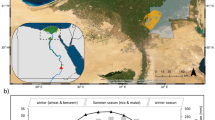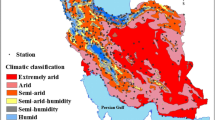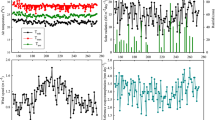Abstract
Remote sensing methods are becoming attractive to estimate crop evapotranspiration, as they cover large areas and can provide accurate and reliable estimations; intensive field monitoring is also not required, although some ground-truth measurements can be helpful in interpreting satellite images. For the purposes of this paper, modeling and remote sensing techniques were integrated for estimating actual evapotranspiration of groundnuts (Arachishypogaea, L.) that is cultivated near Mandria Village in Paphos District of Cyprus. The Surface Energy Balance Algorithm for Land (SEBAL) was adopted for the first time in Cyprus, employing the essential adaptations for local soil and meteorological conditions. Landsat-5 TM and 7 ETM+ images were used to retrieve the needed spectral data. The SEBAL model is enhanced with empirical equations determined as part of the present study, regarding crop canopy factors, in order to increase its accuracy. Maps of ETa were created using the SEBAL modified model (CYSEBAL) for the area of interest. The results have been compared to the measurements from an evaporation pan (which was used as a reference) and those of the original SEBAL model. The statistical comparison has shown that the modified SEBAL yields results that are comparable to those of the evaporation pan. T-test application has revealed that the statistical difference between SEBAL and CYSEBAL is significant and quite crucial, especially in a place with limited surface and underground water resources.




Similar content being viewed by others

References
Alexandridis T (2003) Scale effect on determination of hydrological and vegetation parameters using remote sensing techniques and GIS. PhD Thesis. Aristotle University of Thessaloniki, Greece
Alexandridis T, Chemin Y (2001) Irrigation water consumption through remote sensing. Comparison at different scales in Zhanghe irrigation system, China. Presented in First International Conference on Water Resources Management, Halkidiki, Greece, 10pp
Bandara KMPS (2006)Assessing irrigation performance by using remote sensing. Doctoral thesis, Wageningen University, Wageningen, The Netherlands
Bannari A, Morin D, Huette AR, Bonn F (1995) A review of vegetation indices. Remote Sens Rev 13:95–120
Baret F, Hagolle O, Geiger B, Bicheron P, Miras B, Huc M, Berthelot B, Nino F, Weiss M, Samain O, Roujean JL, Leroy M (2007) LAI, fAPAR and fCover CYCLOPES global products derived from VEGETATION. Part 1: principles of the algorithm. Remote Sens Environ 110:275–286
Bastiaanssen WGM (2000) SEBAL-based sensible and latent heat fluxes in the irrigated Gediz Basin, Turkey. J Hydrol 229:87–100
Bastiaanssen WGM, Menenti M, Feddes RA, Holtslag AAM (1998) A remote sensing surface energy balance algorithm for land (SEBAL), part 1: formulation. J Hydrol 212-213:198–212
Bastiaanssen WGM, Noordman EJM, Pelgrum H, David G, Thoreson BP, Allen RG (2005) SEBAL model with remotely sensed data to improve water resources management under actual field conditions. J Irrig Drain Eng 131:85–93
Clevers JGPW (1989) The application of a weighted infrared-red vegetation index for estimating leaf area index by correcting for soil moisture. Remote Sens Envir 29:25–37
D’Urso G, Menenti M (1995) Map** crop coefficients in irrigated areas from Landsat TM images. In: Proceedings European Symposium on Satellite Remote Sensing II, Europto, Paris, September 1995,SPIE (International Society of Optical Engineering) 2585, 41–47
Glenn EP, Huete AR, Nagler PL, Nelson SG (2008) Relationship between remotely-sensed vegetation indices, canopy attributes and plant physiological processes: what vegetation indices can and cannot tell us about the landscape. Sensors 8:2136–2160
Haboudane D, Miller JR, Pattey E, Zarco-Tejada PJ, Strachan IB (2004) Hyperspectral vegetation indices and novel algorithms for predicting green LAI of crop canopies: modeling and validation in the context of precision agricultural. Remote Sens Envir 90:337–352
Hadjimitsis DG, Papadavid G, Themistocleous K, Kounoudes A, Toulios L (2008) Estimating irrigation demand using satellite remote sensing: a case study of Paphos District area in Cyprus. Proc SPIE Eur Remote Sens, 15–18 September 2008 University of Wales Institute, Cardiff, UK,Proc. SPIE 7104, 71040I (2008);doi:10.1117/12.800366
Huete AR (1988) A soil-adjusted vegetation index (SAVI). Remote Sens Envir 25:295–309
Huete AR (1989) Soil influences in remotely sensed vegetation-canopy spectra. In: Asrar G (ed) Theory and application of optical remote sensing. Wiley, New York, pp 107–141
Kite GW, Droogers P (2000) Comparing evapotranspiration estimates from satellites, hydrological models and field data. J Hydrol 229:3–18
Lang A, McMutrie R, Benson M (1991) Validity of surface area indices of PinusRadiata estimated from transmittance of the sun’s beam. Agric Forest Meteorol 57:157–170
Markou M, Papadavid G (2007) Norm input output data for the main crop and livestock enterprises of Cyprus. Agricultural Economics Report 46, ISSN 0379-0827, p 196–199
Metochis C (1997) Assessment of irrigation water needs of main crops of Cyprus, Cyprus Agricultural Research Institute Series. Ministry of Agriculture, Natural Resources and Environment, Cyprus, Nicosia
Oetter DR, Warren BC, Berterretche M, Maiersperger TK, Kennedy RE (2000) Land cover map** in an agricultural setting using multiseasonal thematic mapper data. Remote Sens Envir 76:139–155
Papadavid G, Hadjimitsis DG (2009)Spectral signature measurements during the whole life cycle of annual crops and sustainable irrigation management over Cyprus using remote sensing and spectroradiometric data: the cases of spring potatoes and peas. Proc. of SPIE, Remote Sensing for Agriculture, Ecosystems, and Hydrology XI, Vol 7472, 747215. doi:10.1117/12.830552
Papastergiadou ES, Retalis A, Apostolakis A, Georgiadis T (2008) Environmental monitoring of spatio-temporal changes using remote sensing and GIS in a Mediterranean Wetland of Northern Greece. Water Resour Manag 22:579–594
Pereira LS, Perrier A, Allen RG, Alves I (1999) Evapotranspiration: concepts and future trends. J Irrig Drain Eng 125:45–51
Petra JG, Hellegers J, Soppe R, Perry CJ, Bastiaanssen WGM (2010) Remote Sensing and Economic Indicators for Supporting Water Resources Management Decisions. Water Resour Manag 24:2419–2436
Qi J, Kerr Y, Chehbouni A (1994) External factor consideration in vegetation index development. Proc. Phys Meas Signature Remote Sens ISPRS, pp 723–730
Qi J, Kerr YH, Moran MS, Weltz M, Huete AR, Sorooshian S, Bryant R (2000) Leaf area index estimates using remotely sensed data and BRDF models in a semiarid region. Remote Sens Envir: 73:18–30
Roerink G, Bastiaanssen WGM, Chambouleyron J, Menenti M (1997) Relating crop water consumption to irrigation water supply by remote sensing. Water Resour Manag 11:445–465
Rogers JS, Allen LH Jr, Calvert DV (1983) Evapotranspiration from a humid-region develo** citrus grove with a grass cover. Trans ASAE 26:1778–1792
Running SW, Coughlan JC (1988) A general model of forest ecosystem processes for regional applications. I. Hydrological balance, canopy gas exchange and primary production processes. Ecol Model 42:125–154
Santos C, Lorite IJ, Allen RG, Tasumi M (2012) Aerodynamic parameterization of the satellite-based energy balance (METRIC) model for ET estimation in rainfed olive orchards of Andalusia, Spain. Water Resour Manag 26:3267–3283
Souch C, Wolfe CP, Grimmond CSB (1996) Wetland evaporation and energy partitioning: Indiana Dunes National Lakeshore. J Hydrol 184:189–208
Spiliotopoulos M, Loukas A, Vasiliades L (2008)Actual evapotranspiration estimation from satellite-based surface energy balance model in Thessaly, Greece. EGU General Assembly, 13-18 April 2008, Vienna, Austria, Geophysical Research Abstracts: Vol 10
Tasumi M, Bastiaanssen WGM, Allen RG (2000) Application of the SEBAL methodology for estimating consumptive use of water and stream flow depletion in the Bear River Basin of Idaho through Remote Sensing. EOSDIS Project Report, Raytheon Systems Company and the University of Idaho, USA
Tiktak A, Van Grinsven HJM (1995) Review of sixteen forest–soil–atmosphere models. Ecol Model 83:35–53
Watson DJ (1947) Comparative physiological studies on growth of field crops: I. Variation in net assimilation rate and leaf area between species and varieties, and within and between years. Ann Bot-London 11:41–76
Welles JM, Norman JM (1991) Instrument for indirect measurement of canopy architecture. Agron J 83:818–825
Author information
Authors and Affiliations
Corresponding author
Rights and permissions
About this article
Cite this article
Papadavid, G., Hadjimitsis, D.G., Toulios, L. et al. A Modified SEBAL Modeling Approach for Estimating Crop Evapotranspiration in Semi-arid Conditions. Water Resour Manage 27, 3493–3506 (2013). https://doi.org/10.1007/s11269-013-0360-x
Received:
Accepted:
Published:
Issue Date:
DOI: https://doi.org/10.1007/s11269-013-0360-x



